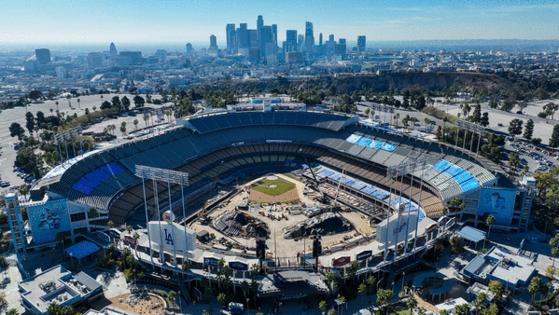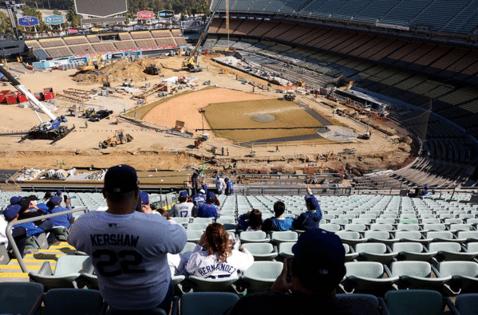'Generational upgrade.' Inside Dodgers' offseason renovations to their new home clubhouse.
Published in Baseball
LOS ANGELES — When the Dodgers’ Guggenheim ownership group first bought the team in 2012, one of their early hires was renowned sports architect Janet Marie Smith.
And in her first couple of months on the job, one of her biggest early tasks quickly became clear.
The clubhouse at the time, she recalled, still felt like a “1962 locker room” — from the shared batting cage and food room used by the home and road teams, to the dilapidated dressing room that still harkened back to the stadium’s opening a half-century earlier.
So, that first offseason before the 2013 campaign, the team did some immediate renovations, updating the space with more modern features and expanding its footprint to a more spacious two-level design.
But over the decade since, a more complete reimagining of the space had been on the club’s bucket list.
This winter, those visions finally became reality.
When the Dodgers begin the domestic portion of their schedule on Thursday, hosting the Detroit Tigers for their home-opener at 4:10 p.m., they will do so in the comfort of a brand-new clubhouse space, having completed an extensive renovation to Dodger Stadium this offseason that centered on transforming the area players will call home for the next six months.
“We felt that what we’d done in 2013 seemed like a marked change,” Smith said this week. “But what we’ve done this year is what [team president] Stan Kasten has described as a ‘generational upgrade.’ ”
In the space of just four months this winter, construction crews gutted the bowels of Dodger Stadium, digging deep trenches down the left- and right-field foul lines to build new, expanded clubhouse areas within the confines of Major League Baseball’s third-oldest ballpark.
When fans arrive Thursday, the results of the work won’t be obvious to the naked eye. From the exterior, the ballpark won’t look much changed from the extensive 2020 renovations Smith oversaw at the stadium, when the outfield pavilions were updated and the center-field plaza was added to become Dodger Stadium’s new “front door.”
But beneath their feet, the Dodgers will be enjoying all the trappings of their new home clubhouse.
They now have expanded weight, training and food rooms. Their once-cramped locker room has been turned into a more spacious, luxurious setting. And, to the excitement of much of the roster, a second batting cage has been installed as well, one fitted with all the trappings of modern training technology in what the team hopes will serve as yet another boon to its superstar-laden roster.
“That clubhouse was amazing,” first baseman Freddie Freeman said after getting his first look during the team’s Freeway Series exhibition game against the Angels on Sunday.
“Really crazy,” added starting pitcher Tyler Glasnow. “Everything was really nice.”
“It’s hard to put into words,” echoed third baseman Max Muncy, one of the longest-tenured players on the roster. “You get so used to something being there and you come in and you have no idea where you’re at. It’s really cool. It’s what you’d expect out of the Dodgers.”
Because Dodger Stadium is built into a hillside in Chavez Ravine, Smith said the only way for the team to create new space for its players and coaching staff was effectively by digging deeper into the ground.
“It would be impossible — and I don’t use that word casually — to go into the hillside to create the space for the clubhouse,” said Smith, whose decorated career includes leading past jobs to build Camden Yards in Baltimore, transform Turner Field in Atlanta from a Summer Olympics venue into an MLB stadium, and renovate Fenway Park in Boston for a second century of use.
“So,” she continued of this winter’s Dodger Stadium renovations, “we took all the seats out, created the space below the playing field, and then created essentially a concrete roof over that” for the pre-existing structure to be rebuilt on top of.
Planning for the project had taken shape over the last two years, with Smith soliciting input from president of baseball operations Andrew Friedman and his front office, members of the coaching staff and playing roster, and virtually anyone else who counts the clubhouse as their workplace on a daily basis.
“I don’t think there’s anyone in the clubhouse who didn’t have some input on their area,” she said. “That’s been really helpful.”
And through those conversations, the reality Smith first confronted a decade ago was only further crystallized as blueprints came together.
“As we worked with our baseball operations team and Andrew Friedman and all of his lieutenants,” she said, “it became clear that what we really needed was not just an appendage to the clubhouse, but a holistic renovation.”
Now, the home clubhouse is a sprawling three-story structure residing beneath Dodger Stadium’s field level. It stretches from behind the third-base dugout all the way down to the left-field foul pole. And it’s so big, Freeman joked that before Sunday’s game, he didn’t even have time to check out all of its new features on his first day there.
“I heard there were [new] sleep rooms,” he said with a laugh. “I haven’t even seen those yet. So yeah, it’s gonna take a couple days to take it all in.”
One of the most notable changes was the expansion of the actual locker room, which transformed from one of the smallest home dressing rooms in all the majors to a more modern space with new stalls complete with mood lighting and digitized nameplates.
Vast improvements were also made to strength and conditioning rooms, something that Smith credited to owner Mark Walter’s goal of making Dodger Stadium “a place where the players feel is there for them 12 months a year,” and also noted as being high on Friedman’s list of suggestions.
“One of the things that Andrew and his team asked for was that our weight room and training room be placed together,” she said, “because the activities between the two are very fluid.”
The team’s full-service kitchen got a facelift, too, having evolved as a place of renewed importance since Dodger Stadium’s last clubhouse renovations in 2013.
Same went with the batting cages — the place many hitters and coaches spend much of their time pregame, and made near-universal requests for the creation of a second hitting tunnel.
“I mean, we made it work with one cage,” Freeman said. “But having two cages, obviously you can get so much more. Guys can work at the same time … We’ll be able to change schedules.”
“More space, more resources,” Freeman added, “means hopefully better things.”
The real surprise from players was how quickly the renovations got done.
Freeman deadpanned that, compared to Dodger Stadium’s four-month timeline, it took a wine cellar he installed at his home “about eight months to do, so I’m kinda confused.” Glasnow added that, at points this offseason, he “honestly didn’t think it was gonna get done” in time for the start of the season.
“But when we walked in, everything was ready to go,” Glasnow remarked this week, his eyes still wide with amazement at the new space. “To all the workers, I don’t know how they did that so quick. It was so much stuff.”
Smith acknowledged the scale of this offseason’s renovations isn’t usually completed so quickly. She estimated that the timeline “probably should have been three times” as long as their four-month construction window. But, to expedite the process, crews from PCL construction, along with hundreds of other subcontractors and vendors who were involved in the job, worked on a seven-day-per-week schedule. Some contractors, Smith said, “have literally not had a day off since January.”
“When they took the job on, it was sort of a pact everyone made: You’re gonna be available,” Smith said. “And everyone stuck to that. … I think people feel real pride in being able to be a part of something that has this kind of cultural relevance to the city.”
Smith’s hope is that fans feel similarly, even if their gameday experience might not look much different when they arrive Thursday.
“I know it’s not a fan-facing space [that we renovated],” she said. “But I think our fans have such a connection to our players and their emotions and their psyche, that I hope they sort of feel that energy resonated.”
With the players, at least, it already is; giving the Dodgers’ defending World Series-winning roster one more thing to celebrate as they open the 2025 season.
“It feels like they created space out of nothing, which they kind of did,” Muncy said. “Everything just feels a whole lot bigger. It’s kind of amazing.”
©2025 Los Angeles Times. Visit at latimes.com. Distributed by Tribune Content Agency, LLC.












Comments